Abstract
The mechanism and site(s) of action of volatile anesthetics are unknown. In all organisms studied, volatile anesthetics adhere to the Meyer-Overton relationship--that is, a ln-ln plot of the oil-gas partition coefficients versus the potencies yields a straight line with a slope of -1. This relationship has led to two conclusions about the site of action of volatile anesthetics. (i) It has properties similar to the lipid used to determine the oil-gas partition coefficients. (ii) All volatile anesthetics cause anesthesia by affecting a single site. In Caenorhabditis elegans, we have identified two mutants with altered sensitivities to only some volatile anesthetics. These two mutants, unc-79 and unc-80, confer large increases in sensitivity to very lipid soluble agents but have little or no increases to other agents. In addition, a class of extragenic suppressor mutations exists that suppresses some altered sensitivities but specifically does not suppress the altered sensitivity to diethyl ether. There is much debate concerning the molecular nature of the site(s) of anesthetic action. One point of discussion is whether the site(s) consists of a purely lipid binding site or if protein is involved. The simplest explanation of our observations is that volatile anesthetics cause immobility in C. elegans by specifically interacting with multiple sites. This model is in turn more consistent with involvement of protein at the site(s) of action.
Full text
PDF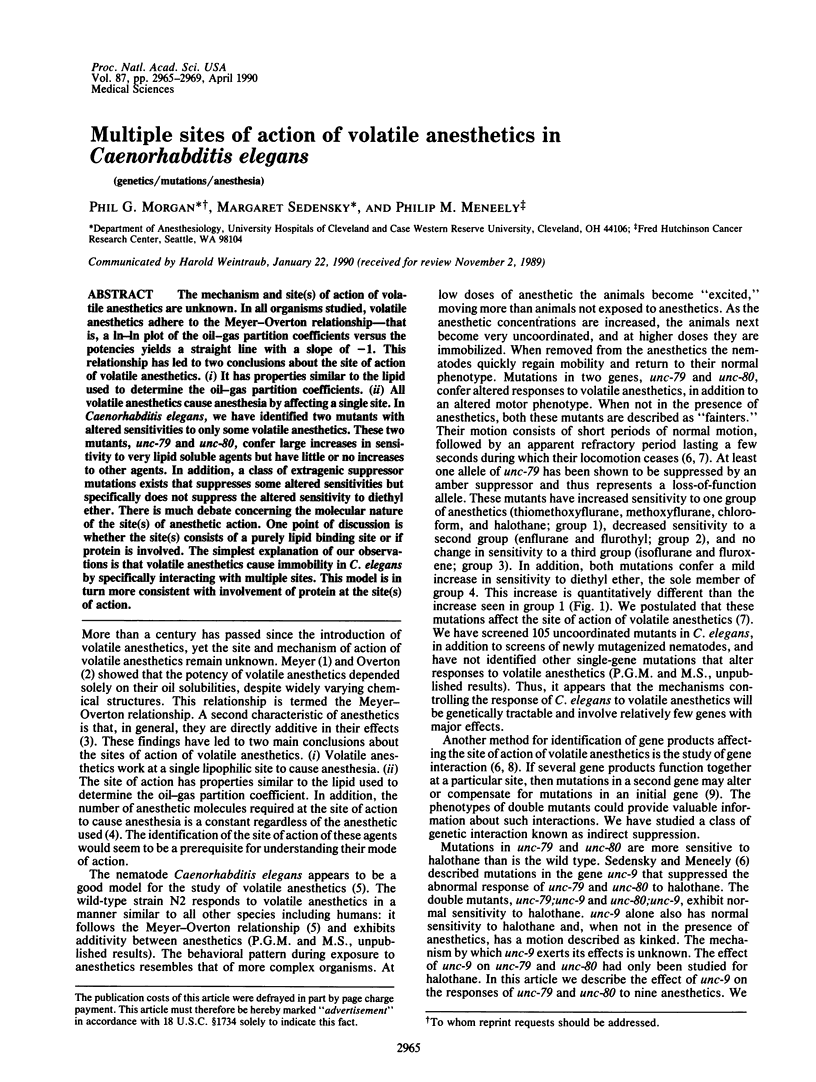
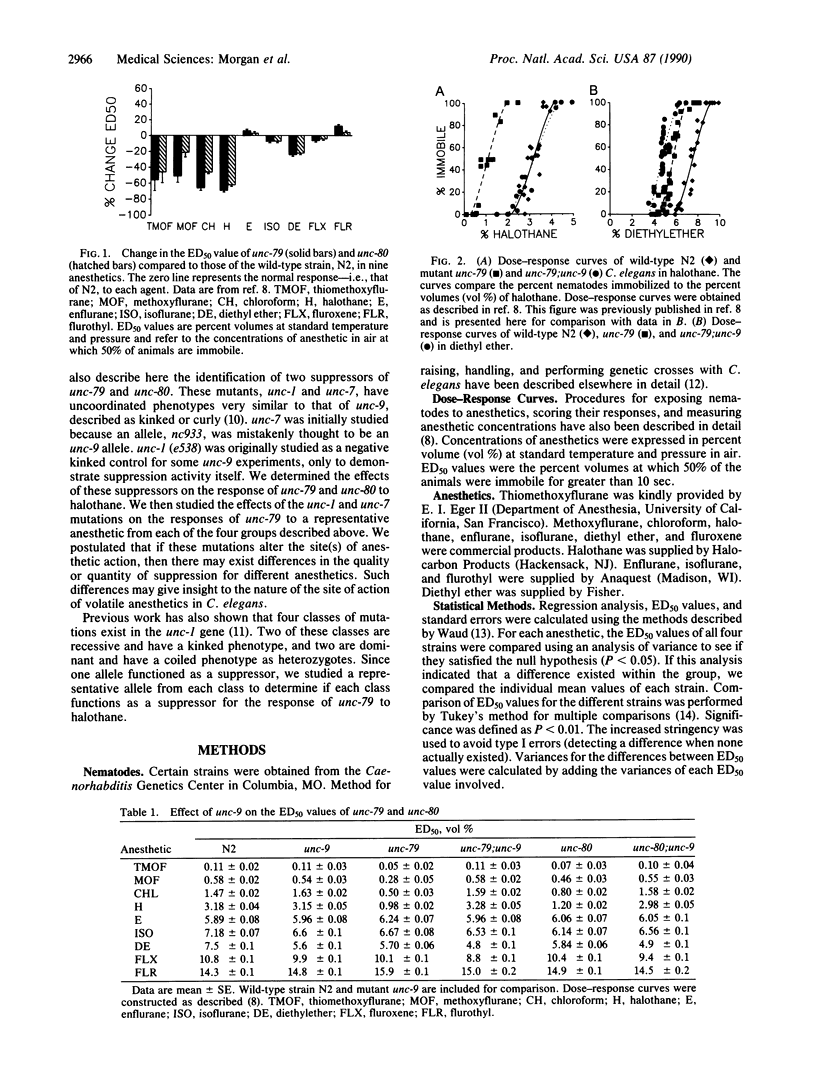
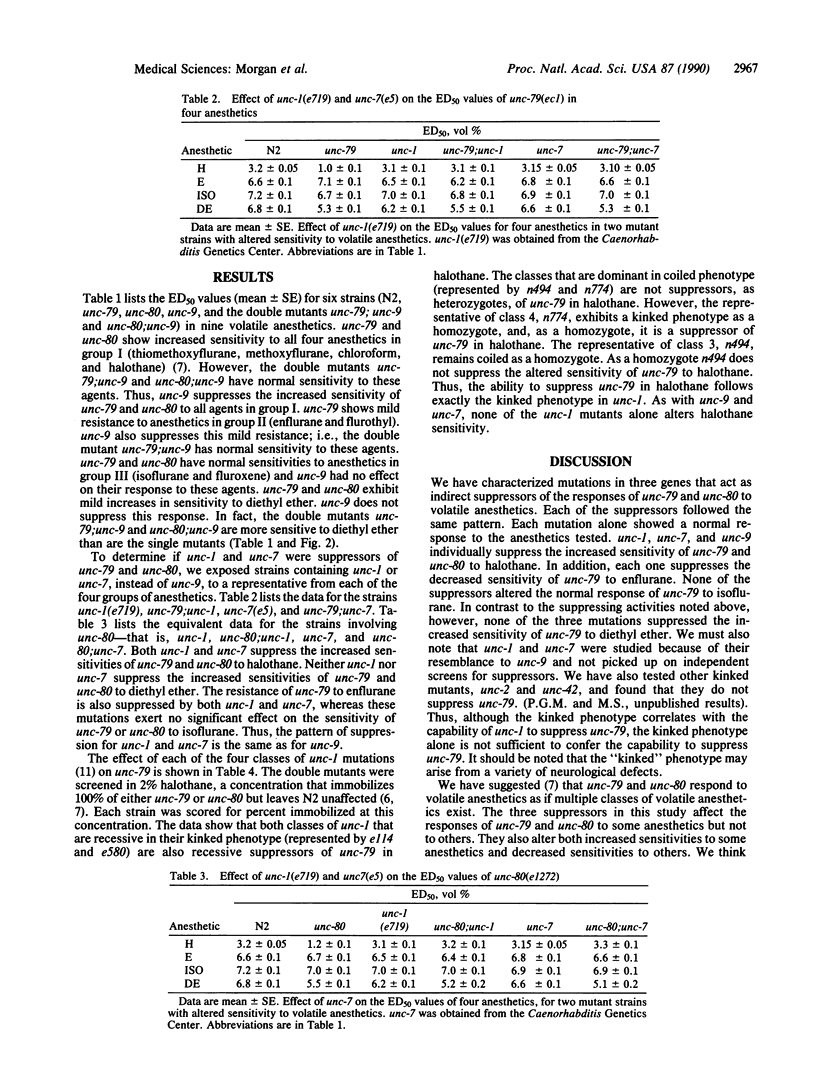
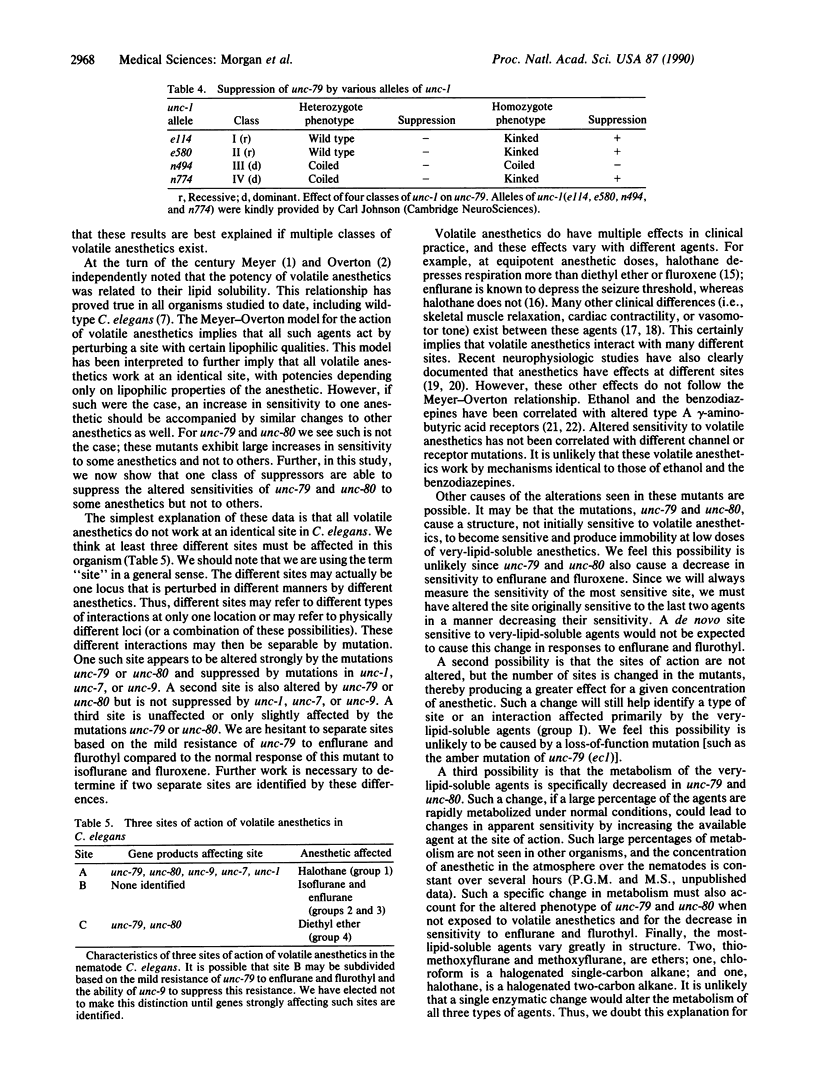
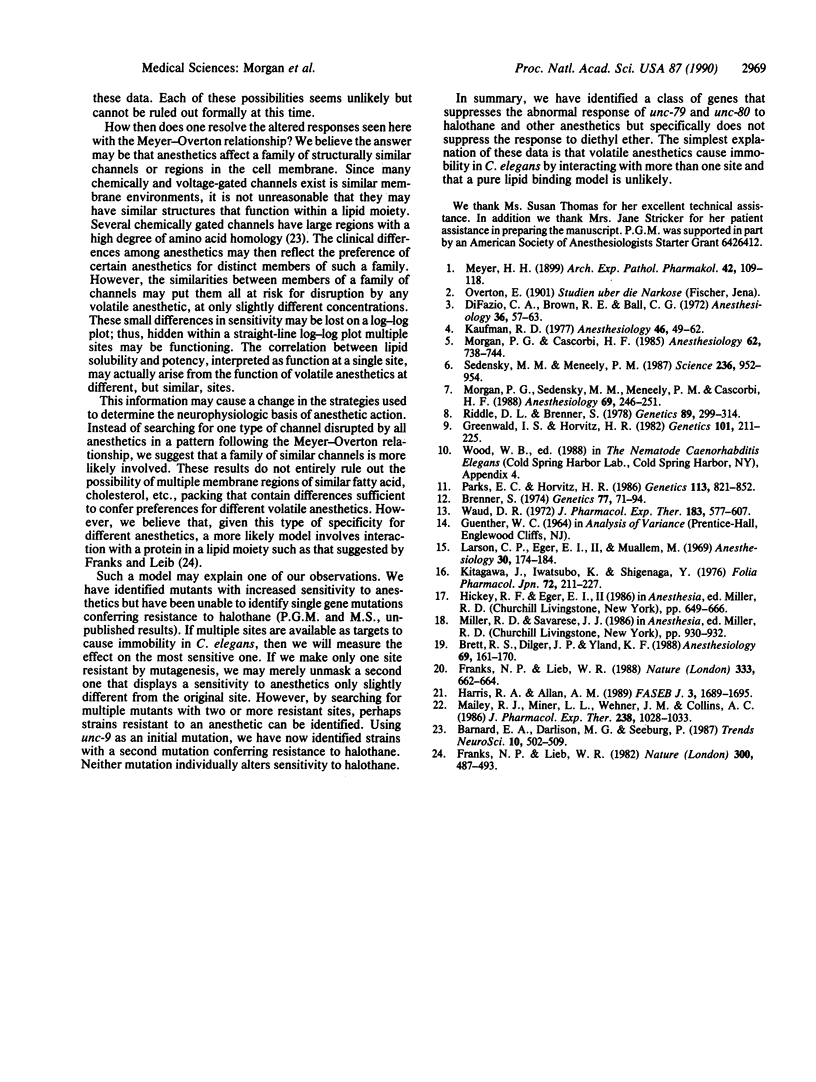
Selected References
These references are in PubMed. This may not be the complete list of references from this article.
- Brenner S. The genetics of Caenorhabditis elegans. Genetics. 1974 May;77(1):71–94. doi: 10.1093/genetics/77.1.71. [DOI] [PMC free article] [PubMed] [Google Scholar]
- Brett R. S., Dilger J. P., Yland K. F. Isoflurane causes "flickering" of the acetylcholine receptor channel: observations using the patch clamp. Anesthesiology. 1988 Aug;69(2):161–170. doi: 10.1097/00000542-198808000-00003. [DOI] [PubMed] [Google Scholar]
- DiFazio C. A., Brown R. E., Ball C. G., Heckel C. G., Kennedy S. S. Additive effects of anesthetics and theories of anesthesia. Anesthesiology. 1972 Jan;36(1):57–63. doi: 10.1097/00000542-197201000-00010. [DOI] [PubMed] [Google Scholar]
- Franks N. P., Lieb W. R. Molecular mechanisms of general anaesthesia. Nature. 1982 Dec 9;300(5892):487–493. doi: 10.1038/300487a0. [DOI] [PubMed] [Google Scholar]
- Franks N. P., Lieb W. R. Volatile general anaesthetics activate a novel neuronal K+ current. Nature. 1988 Jun 16;333(6174):662–664. doi: 10.1038/333662a0. [DOI] [PubMed] [Google Scholar]
- Greenwald I. S., Horvitz H. R. Dominant suppressors of a muscle mutant define an essential gene of Caenorhabditis elegans. Genetics. 1982 Jun;101(2):211–225. doi: 10.1093/genetics/101.2.211. [DOI] [PMC free article] [PubMed] [Google Scholar]
- Harris R. A., Allan A. M. Alcohol intoxication: ion channels and genetics. FASEB J. 1989 Apr;3(6):1689–1695. doi: 10.1096/fasebj.3.6.2467834. [DOI] [PubMed] [Google Scholar]
- Kaufman R. D. Biophysical mechanisms of anesthetic action: historical perspective and review of current concepts. Anesthesiology. 1977 Jan;46(1):49–62. doi: 10.1097/00000542-197701000-00010. [DOI] [PubMed] [Google Scholar]
- Kitagawa J., Iwatsubo K., Shigenaga Y., Inoki R. [Pharmacological comparison between enflurane and halothane]. Nihon Yakurigaku Zasshi. 1976 Mar;72(2):211–227. doi: 10.1254/fpj.72.211. [DOI] [PubMed] [Google Scholar]
- Larson C. P., Jr, Eger E. I., 2nd, Muallem M., Buechel D. R., Munson E. S., Eisele J. H. The effects of diethyl ether and methoxyflurane on ventilation: II. A comparative study in man. Anesthesiology. 1969 Feb;30(2):174–184. doi: 10.1097/00000542-196902000-00014. [DOI] [PubMed] [Google Scholar]
- Marley R. J., Miner L. L., Wehner J. M., Collins A. C. Differential effects of central nervous system depressants in long-sleep and short-sleep mice. J Pharmacol Exp Ther. 1986 Sep;238(3):1028–1033. [PubMed] [Google Scholar]
- Morgan P. G., Cascorbi H. F. Effect of anesthetics and a convulsant on normal and mutant Caenorhabditis elegans. Anesthesiology. 1985 Jun;62(6):738–744. doi: 10.1097/00000542-198506000-00007. [DOI] [PubMed] [Google Scholar]
- Morgan P. G., Sedensky M. M., Meneely P. M., Cascorbi H. F. The effect of two genes on anesthetic response in the nematode Caenorhabditis elegans. Anesthesiology. 1988 Aug;69(2):246–251. doi: 10.1097/00000542-198808000-00015. [DOI] [PubMed] [Google Scholar]
- Park E. C., Horvitz H. R. Mutations with dominant effects on the behavior and morphology of the nematode Caenorhabditis elegans. Genetics. 1986 Aug;113(4):821–852. doi: 10.1093/genetics/113.4.821. [DOI] [PMC free article] [PubMed] [Google Scholar]
- Riddle D. L., Brenner S. Indirect suppression in Caenorhabditis elegans. Genetics. 1978 Jun;89(2):299–314. doi: 10.1093/genetics/89.2.299. [DOI] [PMC free article] [PubMed] [Google Scholar]
- Sedensky M. M., Meneely P. M. Genetic analysis of halothane sensitivity in Caenorhabditis elegans. Science. 1987 May 22;236(4804):952–954. doi: 10.1126/science.3576211. [DOI] [PubMed] [Google Scholar]
- Waud D. R. On biological assays involving quantal responses. J Pharmacol Exp Ther. 1972 Dec;183(3):577–607. [PubMed] [Google Scholar]


